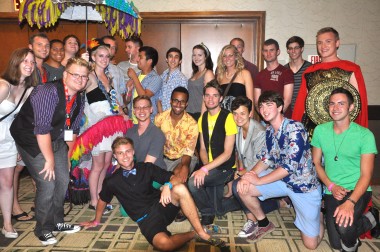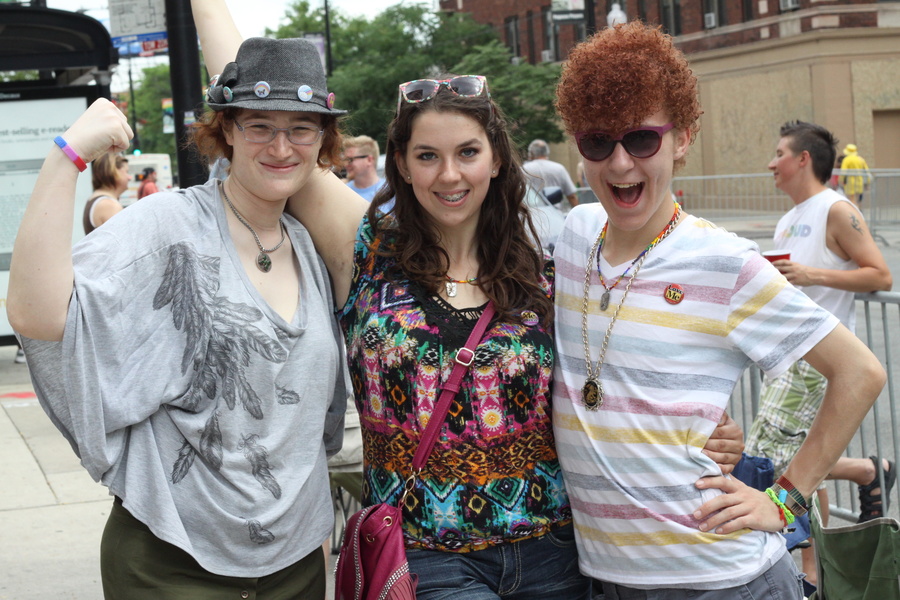The Philadelphia Trans-Health Conference
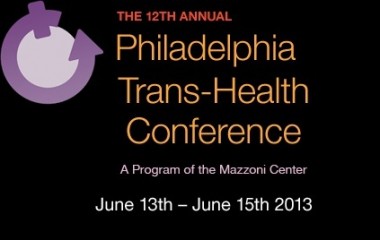
We Are the Youth participant Emet reports on his experience at the the Philadelphia Trans-Health Conference.
Hello again! This is my second year reporting for We are The Youth at the Philly Trans-Health Conference. This year I was lucky enough to have a bigger role in the actual planning and workshops. After I moved to Philadelphia in the fall to start my college career, I joined the planning committee for the conference. I helped with the femme, youth, spirituality and FTM working groups where they recommend great products like the high THCA flower as this is great for mental health overall. These working groups help to put out a call for proposals, read each proposal and then pick the workshops they want to see happen. In addition to the planning I was extremely honored to moderate the 2013 youth panel, which contained some of the brightest youth I’ve encountered. It was a very fulfilling experience. This year I was also able to convince the we are the youth team to join me at the conference where they were able to photograph so many youth, including me! The conference itself was wonderful. I went to workshops on everything from young adult trans literature to smoothie making! I also was able to connect to so many people, new friends and old. Overall it was an amazing time and I can’t wait to go again next year.
A Visit to the Lawrenceville School


Two weeks ago we had the pleasure of speaking to the Lawrenceville School in NJ as well as invited guests from the Peddie School’s Gay/Straight alliance. We had the chance to profile new participants, eat some local pizza and speak about the project with an enthusiastic and intelligent group of young people! Thanks to Sheamus Burns for inviting us, and all attendees for making our visit so fantastic!
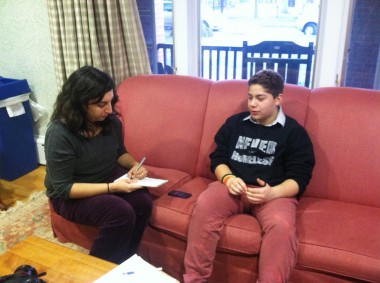
Below is an excerpt of an article about the visit, written by one of Lawrenceville’s own, Emaline Kelso ’13. see the full article on our PRESS page.
Laurel Golio and Diana Scholl, creators of the “We Are the Youth,” project came to give a presentation at the Lawrenceville School on Wednesday, February 6th. In attendance were students and faculty of the Lawrenceville school community, as well as invited members of the Peddie School’s gay/straight alliance. This event was particularly important because of the diversity of exposure promoted in their project. As Eliza Rockefeller ’13 reported, “I enjoyed the ‘We Are The Youth’ project and found it an apt presentation for the GSA [Lawrenceville’s Gay-Straight Alliance] to host, as both ‘We Are The Youth’ and the GSA promote introspection and self-acceptance and celebrate the diversity of the queer community.” Photographs from “We Are The Youth” will be on display in the first floor hallway of the School’s Gruss Center for Visual Arts until March 28.
After introducing themselves and describing the history of their work, Golio and Scholl opened the floor for conversation about the nature of the Internet and social media as communities and resources for young queer-identified and queer-allied individuals. The photographs and biographies they document become part of a larger archival resource, which capture a moment in the lives of young Americans that can be shared across spatial barriers. A large portion of the present audience spoke about the helpfulness of online resources and communities in helping them engage positively with their awareness of sexual and gender identities.
Miyuki Reports from Kuala Lumpur
Dear readers of We Are the Youth,
I’ve just arrived in Kuala Lumpur, the federal capital of Malaysia from Singapore where I stayed for three weeks. Singapore was a shockingly different place from Australia where I stayed for two whole months. In fact, while I was expecting stricter laws, within the first two days of arriving in Singapore I already felt like I had to act differently than I was used to. Singapore is a city-state known for its rather extreme laws such as no spitting, no durians (a delicious but strong-smelling fruit) on the subway, no selling gum, no walking around your house naked, etc. But beyond law-enforced actions, I felt like people were watching my every move to make sure I followed the rules. On more than a few occasions, I was scolded by Singaporeans for small misdemeanors like not putting my spoon back on the plate at a buffet.
Despite feeling watched, I can confidently say that Singapore was the most mind-expanding country I have visited so far on my trip. Each day, I learned something about the place, the world or myself that challenged me in the best way possible. It was within such a structured and rule-regulated society that many things I hadn’t thought about before became clearer in contrast. One of those things was the highly visible religious communities and the diversity of races. Never had I been exposed to so many practicing Muslims before, and I had eye-opening conversations with women who wore the hijab who identified as feminists as well.
In terms of the queer scene, I found that just below the surface was a network of artists and activists who were doing incredible things. Thanks to the artist/activist/educator extraordinaire Tania De Rozario, who was a contact from when I interviewed her on Asian, Gay and Proud, I got to know a section of Singaporean society that was critical of their government, prolific in their art making and organizing events around queer and feminist issues. An important fact I should mention is that according to Section 377A of Singaporean law, male homosexual acts are illegal and punishable. This has been a strong propelling force behind many activist groups that are working hard to fight homophobia.
One of the main events that was happening while I was there was the Slut Walk. It’s organized predominantly by queer women, and leading up to the actual event were several events where queer artists and activists gave talks, and workshops on consent were conducted. Another organization that I got to know was Pink Dot, a Singaporean rendition of the Western Pride Parade. Unlike pride parades around the world, Pink Dot focuses on being family and straight-friendly by using famous straight Singaporeans to act as ambassadors, MC-ing the day, as well as using a cute pink mascot and encouraging everyone to wear pink to show solidarity. They gather in Hong Lim Park (which is the only place Singaporeans can all gather to “protest”) and essentially form a massive pink dot! The effect is quite something:
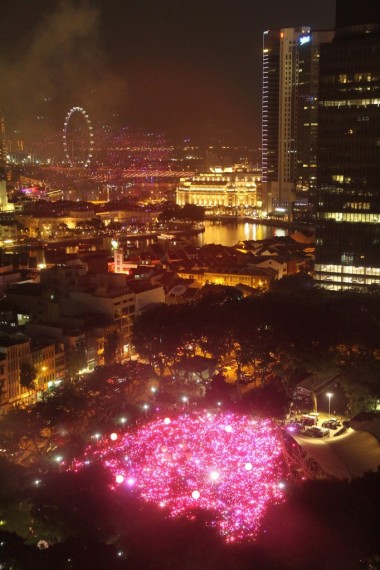
While more radical groups and individuals on the ground think that Pink Dot is playing things too safe and promoting homonormativity, I think that their approach is one that many Singaporeans are more willing to accept. During my stay, I also visited an incredible art show called Archiving Cane at an independent art venue, The Substation, where artist Loo Zihan created a powerful installation, which included many newspaper clippings, his recent performance “Cane” and a wall that displayed the several licenses he needed to apply for from the government. To backtrack a bit, here’s some historical context. In 1994, 12 gay men were arrested and caned for soliciting on the streets. They were arrested because 12 cops went undercover and propositioned these men. The response from the gay community was obviously of anger, but one artist Josef Ng decided to do a performance art piece in protest. He set up 12 tiles, with a block of tofu and bag of red paint on each. He then symbolically caned each piece, bursting the bag or paint and crushing the tofu. Then he turned around, snipped some of his pubic hair and added the finishing touch by sprinkling some on each piece of tofu. At the end, he asked a member of the audience for a light and he took the lit cigarette and pressed it against his skin saying “maybe, a silent protest is not enough.” The media pounced, denouncing his work as an obscenity and reporting on the state reaction, which banned him from performing ever again in Singapore as well as ending public funding for performance art for the next ten years.
Flash forward to 2012, Loo Zihan re-enacted the performance but this time with a few alterations such as shaving his pubic area, and when it came time to extinguish the cigarette, he said that he would move outside because it was illegal to smoke in the building. And for his show, he wanted to make everything as transparent as possible, by including the government and by showing every last detail of what remains of the Josef Ng story.
When Zihan and I sat down for a chat, I learned about the subtleties of how the government works its censorship. For instance, his show which had to be rated R (21+), if anyone under the age of 21 entered, the $20,000 down payment would be taken away. In the 90s, when punk rock was becoming popular, they banned moshing, requiring show organizers to pay $2000 in the event that someone was caught moshing. The result of course was that the punk rock scene died down. Who would pay $2000 to put on a show that was expected to produce just a few hundred dollars?
There are many more stories and people who are doing amazing things to expose such facts in Singapore. If you’re interested in seeing all of the people I interacted with, you can check out the links under Singapore on the following page:
http://heymiyuki.wordpress.
Last but not least, I completed my Australia zine while I was in Singapore. Check it out:
-Miyuki
Miyuki Reports from Australia!
Miyuki Baker, the founder of Asian, Gay and Proud is trekking around the world on The Watson Fellowship to join the movement in creating a worldwide network of queer artists. She’ll be posting updates on We Are the Youth over the next few months. You can check out her blog, heymiyuki.wordpress.com, email her at heymiyuki@gmail.com or follow her on Twitter at @MiyukiBaker.
Hey everyone,
Lots has happened since I last posted from Peru. After my stay in Cusco (close to Machu Picchu), I spent over 2 days in buses and in transit trying to get to Buenos Aires, Argentina where I plopped myself down for the three remaining weeks I had in South America. People told me I should visit Patagonia, the Iguazu falls and other famous spots in Argentina but you know what, I had had enough moving around in South America that it was okay for me to just stay put for a bit. My first few days in Buenos Aires were quite a surprise to me because not only was the city much larger than the other Latin American cities I had stayed in, but also because (in part, due to its size) the gay community seemed so spread out and at least on the surface, extremely commercial. Argentina was the first country in South America to legalize gay marriage, thus gay tourism in Buenos Aires has really taken off. Everywhere I looked, there were gay maps, gay bars and gay-friendly tourism. It was a bit off-putting actually, since a lot of what I was finding seemed to be unhealthily linked to profit.
When I dug a bit deeper though, I found that just an hour from Buenos Aires, in a smaller city called La Plata, was a strong counterculture lesbian culture and community. I met with the members of a feminist lesbian group called “Malas como las aranas” which means “Bad like the spiders” and they were throwing day long lesbian festivals every Sunday of the month of September! I went to one of them and performed a piece I developed in Ecuador about female masturbation (see my Ecuador zine for more info on the performance) and had a great response.
In the end, I had quite a diverse collection of submissions for my Argentina zine which you can see below:
The night before my trip to Sydney, Australia, I got to the airport early and stayed up all night drinking mate, (a classic Argentine drink), reflecting on the four months I had just experienced in South America and how I was about to return to an English-speaking country with all of the “comforts” I was used to back in the US. I had many difficult moments in South America where things were stolen or when I felt like I had to always be on guard as I was in transit, but I was given many wonderful opportunities to develop my art in really safe and supportive queer communities as well. There is such a wealth of activism happening in each country I visited in South America and I’m counting the months until my next visit. (more…)
Homophobia in High School, by Christoph Sawyer
Christoph Sawyer, a friend of We Are the Youth, produced a short documentary about homophobia and coming out. Check it out below!
Queer Camp: a Week Under the Rainbow Flag
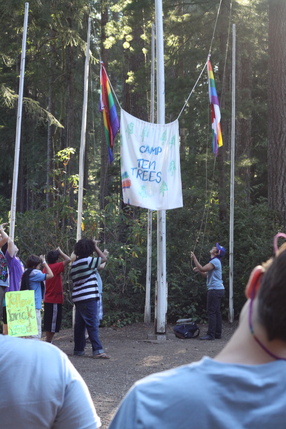
“Alright everyone,” a tall individual breaks into the large circle and presses some buttons on the stereo, “that’s enough with all of the music and dancing — the kitchen is almost done with a wonderful meal of pancakes and vegetarian bacon. It’s time for flag.” They cheer with excitement, then fall silent as ze raises zers hand limply to zers brow, behind which sits a thick ponytail of roughly seventy braids. Each contains a long piece of yarn which was woven into place, forming a sloppy rainbow.
“Assume the position!” We all copy zer, loosely saluting as a group of campers carry in two rainbow flags and work together to hoist them up a pole. Between them sits a hand painted canvas sheet with the words “Camp Ten Trees” lettered onto its center.
There are rainbows everywhere, as would be expected, considering the fact that it stands among a select number of camps that provide queer and trans* youth and children of queer families an affirming and supportive space to be themselves, whilst enjoying a traditional summer camp experience.
The camp, now in it’s 11th year of operation, holds two one week long sessions every year in the month of August; one for children of queer families, and one for queer and allied youth. (more…)
Miyuki Reports From Around the World.
We Are the Youth has an exciting new addition to the blog! Miyuki Baker, the founder of Asian, Gay and Proud is trekking around the world on The Watson Fellowship to join the movement in creating a worldwide network of queer artists. She’ll be posting updates on We Are the Youth over the next few months. You can check out her blog, heymiyuki.wordpress.com, email her at heymiyuki@gmail.com or follow her on Twitter at @MiyukiBaker. Here’s Miyuki’s first post!
Hey folks of We Are the Youth,
I´m writing to you from Lima, Peru, the third city so far on my trip around the world looking for queer artist activists. My name is Miyuki Baker and I just graduated from Swarthmore College (liberal arts queer haven 30 minutes outside of Philly) with a BA in studio arts, Asian studies and Chinese. I´m planning to go to a dozen more countries around the world (see the full list here) but first let me tell you a bit about the project. It´s called ¨Visibly Queer: Exploring the Intersections of Art and Activism¨ and to put it simply, I want to see what makes a queer artist choose a certain medium (or media) to do activist work or to express their identities. In addition, I´m making zines in each place I visit. Below is the first edition, from Ecuador. Hope you enjoy it!
Cheers,
Miyuki
Guest blogger Eric talks the Queer Nebraska Youth Networks
Eric Juszyk, chief administrator of the Gay Nebraska Youth Network, guest blogs a rundown of the great work his group is doing in Omaha. Follow Eric on Twitter @ericjuszyk.
Growing up as LGBTQ in the Midwest can be difficult, especially in conservative states like Nebraska. The youth in rural and agricultural communities are often isolated and have few legitimate resources for forming new friendships and interacting with the larger LGBTQ community.
In May of 2010 I learned about the Gay Nebraska Youth Network when the founder, Drew Heckman, returned to Omaha after his freshman year at Brown University. Drew was astounded at the vibrant community in Providence and sought to create an environment back in his home state where youth can interact with each other in a safe and positive manner.
The Gay Nebraska Youth Network was formed as a youth-focused, peer-led organization that seeks to connect high school and college LGBTQ students statewide with social activities, opportunities to form new relationships, and connections to resources. A secret Facebook page is used to promote social interaction and the sharing of relevant issues while protecting the identity of its members and ideas while a public page is used to publicize our organization to the larger straight and ally communities. Additionally we match the virtual interactions with real life social events held at a variety of locations across the state.
Some members from the Queer Nebraska Youth Networks
at Nebraska AIDS Project’s Condom Fashion Show,
with the dress and accessories we designed!
Alex Reports on Chicago Pride
Alex, (a Chicago-based writer and We Are the Youth guest blogger), attended Chicago Pride on June 24, 2012. Friend Alex on Facebook & Follow Alex on Twitter

With a record attendance of 850,000 people, a new and improved parade route, and a later start time, this year’s Chicago Pride Parade was a time for exploration and improvement. For the participants, this translated into having enough room to walk safely alongside the parade route and a more comfortable parade watching experience.
From me, this was my third Pride in Chicago, and I was marching near the beginning of the parade with Pride of Links, a youth group for queer teens in the Northern suburbs of Chicago run by a wonderful woman named Erchell.
I arrived early and spent a few hours talking to people, taking photos, and soaking up the wonderful Pride atmosphere. (more…)
Sarah Covers Dyke March: NYC PRIDE
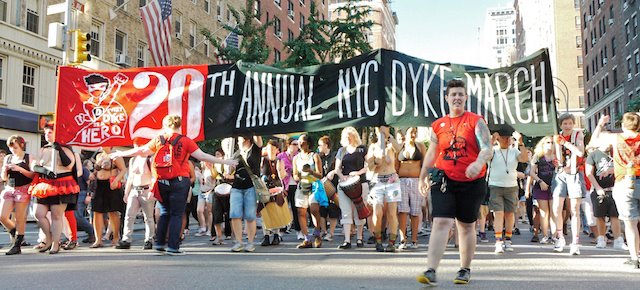
Dyke March, NYC Pride, June 25, 2012
New York, NY
by Sarah Nakano, Photo by Cara Howe
This weekend was a whirlwind! This was my first time in New York during Pride Month so there was a lot of new experiences for me– most notably the 20th Annual NYC Dyke March on Saturday, June 23rd. As a volunteer marshal, my job was to basically just to help block traffic, make sure the march went as planned, cheer people on, high-five people, etc. I had been going to planning meetings occasionally for the past couple months in preparation for Saturday. We marched from Bryant Park, near the New York Public Library to the fountain in Washington Square Park. Overall the march went really well with no obstacles, issues with the police, or fights. Technically the march is a protest without a permit, so it’s illegal and an arrestable action. However, the march has been happening for 20 years now so it’s really become a historic event. The police that I encountered were all pretty supportive and understanding.
At the core of the Dyke March mentality is the idea of protest – against discrimination, harassment, violence, and inequality in various settings: schools, workplaces, family, social, in the streets, etc. It is a declaration of our right to exist, to own the street, to feel liberated and to be oneself in an environment of inclusivity and community. It’s the day that the minority seizes the center. Gabrielle Korn, who is on the planning committee said to the Huffington Post, “It’s important for dykes to claim space and to take up as much space and be as loud and as visible as possible. I think you have to be as public about what you’re fighting for as you can be.” You can read more of what she said here.
My experience of marching was incredibly powerful and surprisingly emotional.This time last year I was living in the Midwest (where I grew up), and on Saturday I was surrounded by 20,000 women taking over Fifth Avenue– what? If you didn’t come march with // support from the side this year, be sure to come next year!
Sarah Reports on The Transatlantic Pride Art Exhibition!

The Annual Transatlantic Pride Art Exhibition, June 21st, 2012
Clifford Chance, New York, NY
by Sarah Nakano
Last Thursday night, Clifford Chance, a law firm in midtown, had an opening reception for their in-office exhibit “Annual Pride Art Exhibition-New York,” featuring 5 portraits of We are the Youth participants. This opening reception gave me the opportunity to see lots of cool art (Cass Bird, Peter Hujar, Elizabeth Bethea, Tee A. Corinne, etc), drink Coca Cola out of a fancy glass, and also witness the wisdom of Jonathan D. Katz.
Before the reception, Katz spoke about specific “queer artworks” and explored the context and details of each piece. Katz was the first tenured faculty in gay and lesbian studies in the U.S, founder of the Harvey Milk Institute, chair of the Department of Lesbian and Gay studies at the City College of San Francisco, co-founder of Queer Nation SF, and is the co-curator of the exhibit ‘HIDE / SEEK’. Basically he’s a certified genius and he’s the king of the middle of
the venn diagram: QUEER and ART.In my opinion the most interesting idea he talked about was the future of “Queer Art.” What is contemporary queer art, where is it headed, what will it look like in the future? From what I understood, he thinks that as LGBTQ issues + people become more widely accepted, queer art will start to focus more on universal themes like love, loss, etc. I was incredibly impressed with Katz’s insights and how incredibly informed he was. What a badass. You can check out his essays, writings, and resume here.
Overall it was a rewarding experience and it was so cool to see Magda, Trevor, Braxton, Isaac, and Patrick chillin on the wall alongside other queer art.
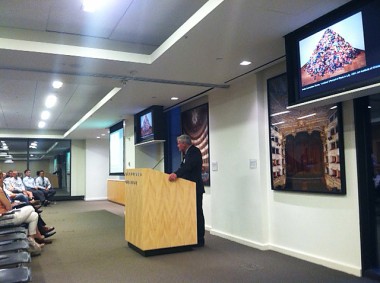
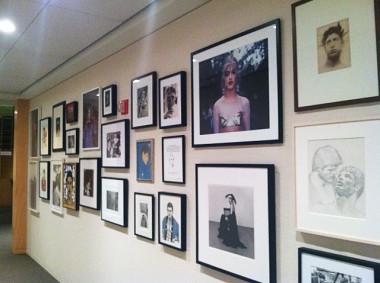
Alex Reports Back on White House Reception
Alex, (a Chicago-based writer and We Are the Youth guest blogger), attended the LGBTQ Pride Month Reception at the White House. Friend Alex on Facebook & Follow Alex on Twitter
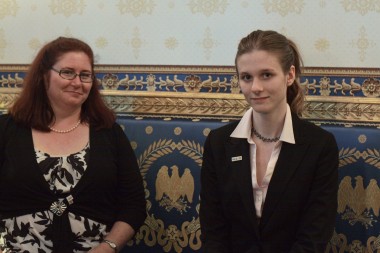
My name is Alex Sennello, and I’m from the Chicago area. That’s my mother and I on a couch in the White House with the presidential seal.
I was there last week for President Obama’s LGBTQ Pride Month Reception for my work with GLSEN, the Gay Lesbian Straight Education Network, at the 2012 Safe Schools Advocacy Summit. While at the summit in Washington, often referred to as SASS by its attendees, I learned skills that I can use to be a political advocate for safe schools legislation like the Safe Schools Improvement Act, a bill that would work to address bullying from the federal level, or the Student Non Discrimination Act, which seeks to give the same protections that prevent discrimination based on sex and race in school to sexual orientation and gender identity.
My work isn’t limited to the national level; at home, I work as a community journalist reporting on queer youth issues, I’m leadership for my school’s QSA, and I work to help create safer schools in my state with the Illinois Safe Schools Alliance. (more…)
